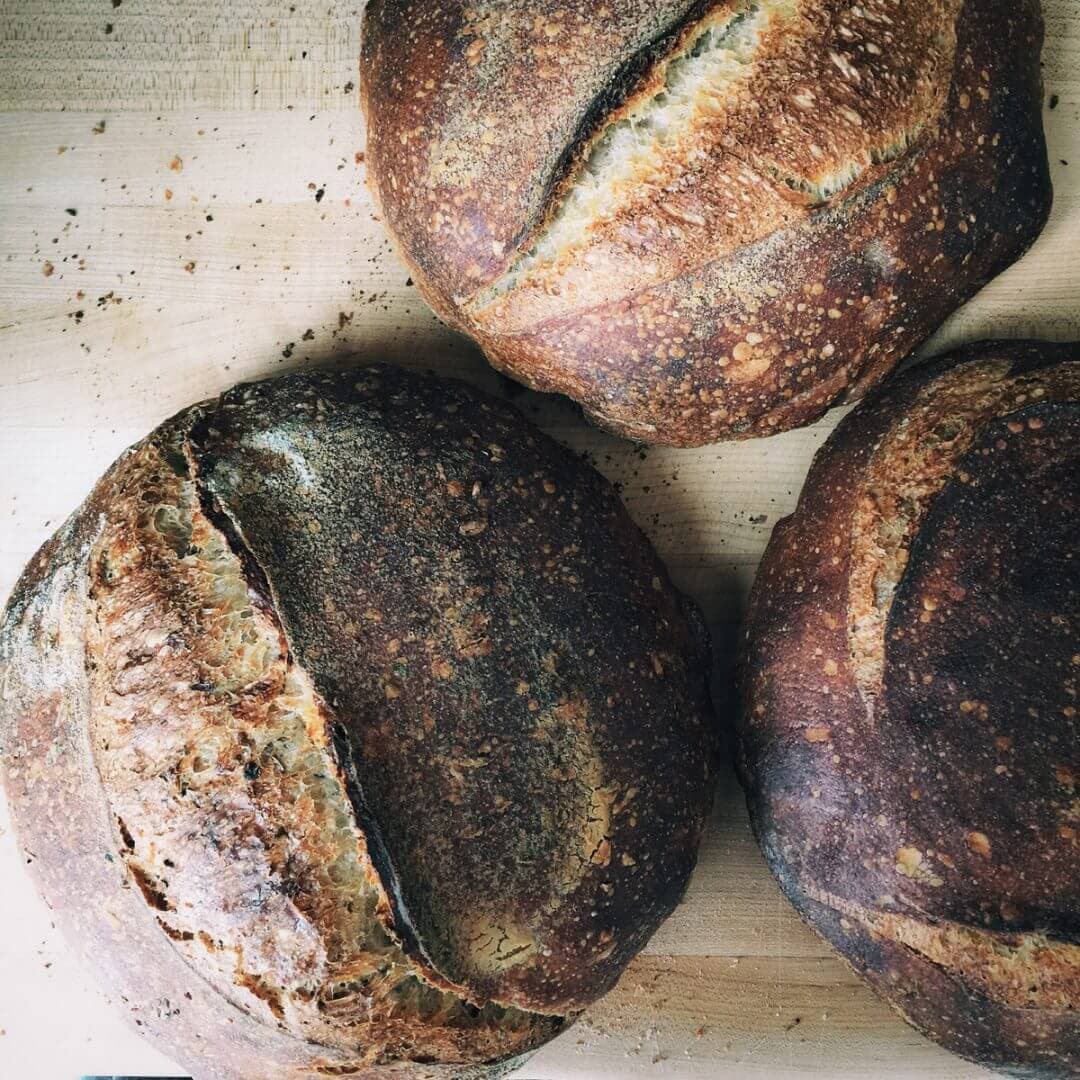The beer scene here in New Mexico has taken off with some of the country’s top-ranking breweries, and several of their recent entries in the Great American Beer Festival have earned gold, silver, and bronze medals. Notably, Marble Brewery 1 was named Small Brewing Company of the Year—a fantastic thing for a city like Albuquerque. With so much beer talk and so many beer purchasing options for every night of the week, it’s also motivated many would-be-brewers to try their hand right in their own homes. Shops around town sell a multitude of grain varieties worldwide and all the tools and necessities one would need to get started. Several of my good friends have picked up this beautifully serious hobby and have made some stunningly good beer, so good I could have sworn they picked up a microbrew 6-pack and did a behind-the-scenes-swap before I could spot them. And since my friends are brewing more than ever, it means an easy way to make this sourdough with spent beer grains.
It’s interesting to hear my friends talk about beer because you know what, it sounds exactly like the sort of processes we bakers go through to make a great loaf of bread. Yeast, bacteria, fermentation, sugar & starches, and temperature control: all the things we wrestle and wrangle with to cajole those tall, dark loaves out of the oven. As one of my friends quipped, “fermentation, man, it’s a wonderful thing.” Indeed.
You might have heard somewhere, at some point, that beer merely is “liquid bread.” Well, there is a little bit of truth to that statement. German monks adhering to their religious duties at certain times of the year2 would abstain from eating almost all solid foods. One way to “cope” with this restriction was to cook and ferment their bread grains, thereby converting their bread into “liquid bread” to be consumed in copious quantities. It sounds more like a 46-day party than religious atonement.

I digress. As my friends and I chatted on, and I discovered more and more about their process, I found there is a fair amount of waste when a batch of beer is made. Grains that are soaked to release starches as food for brewer’s yeast are mostly thrown out after they produce what’s needed, wasting what could be used as a nutritious component to many dishes. More on the process below, but I asked a few of them to save their spent grains for me so I can perform a set of test bakes and determine what taste profile these grains would have on the resultant bread. In a few words: a very hearty bread. I’ll get back to the taste and flavor later on, but that sums it up in a nutshell.
What exactly are “spent grains”?
One of the first steps in brewing beer is to make food for brewer’s yeast to consume and produce alcohol. This step is dubbed “mashing”: you mix hot water with grains, usually malted barley, which converts the starches in the malted grain to a sugary liquid that will later be used in conjunction with the brewer’s yeast to start fermentation. As fermentation progresses, the yeast metabolizes the sugars in the liquid producing alcohol and carbon dioxide, essentially turning this liquid (“wort”) into beer. This process is very similar to how our sourdough starters ferment, feeding off the sugars converted from the starches in the flour, producing alcohols, acids, and carbon dioxide.
After you extract the sweet, starchy liquid from mashing the leftover grains, these spent grains are no longer needed. Some breweries will either donate or sell the spent grains to farms for feeding livestock or a variety of other uses. For the home brewer, however, it is usually thrown away or composted.
Instead of just pitching these grains, why not put them to good use, like, in bread.
Preserving Spent Beer Grains
Like other cooked grains I’d imagine these would last probably a week or so in the fridge. My friend’s small batch of beer produced quite a big bag for me to use and I ended up freezing three-quarters of the bag for a later date. I just wrapped the grains up in several layers of saran wrap and placed them into two nested freezer bags.
Next time I receive a large bag like this I plan to split them up into small containers with a small amount in each, say 250 grams as I used in the recipe below, and then defrost a bag at a time per my baking requirements.
Prepare the stiff levain – 9:30 a.m.
For a description of my stiff starter and levain, see my earlier post on its benefits and how it compares to my typical liquid one. For this bread, I decided to use my stiff starter to help confer strength to the highly hydrated final dough.
| Weight | Ingredient |
|---|---|
| 50g | Ripe stiff starter |
| 50g | Giusto’s whole wheat flour |
| 50g | Central Milling Organic Artisan Bakers Craft (malted, unbleached white flour) |
| 65g | Water |
Keep your stiff levain in a warm area and wait about 5 or so hours until it’s matured enough to leaven your dough. Time to take a walk with the dog, do some chores, or if you’re like me, read some more about sourdough and plan for the next bake.
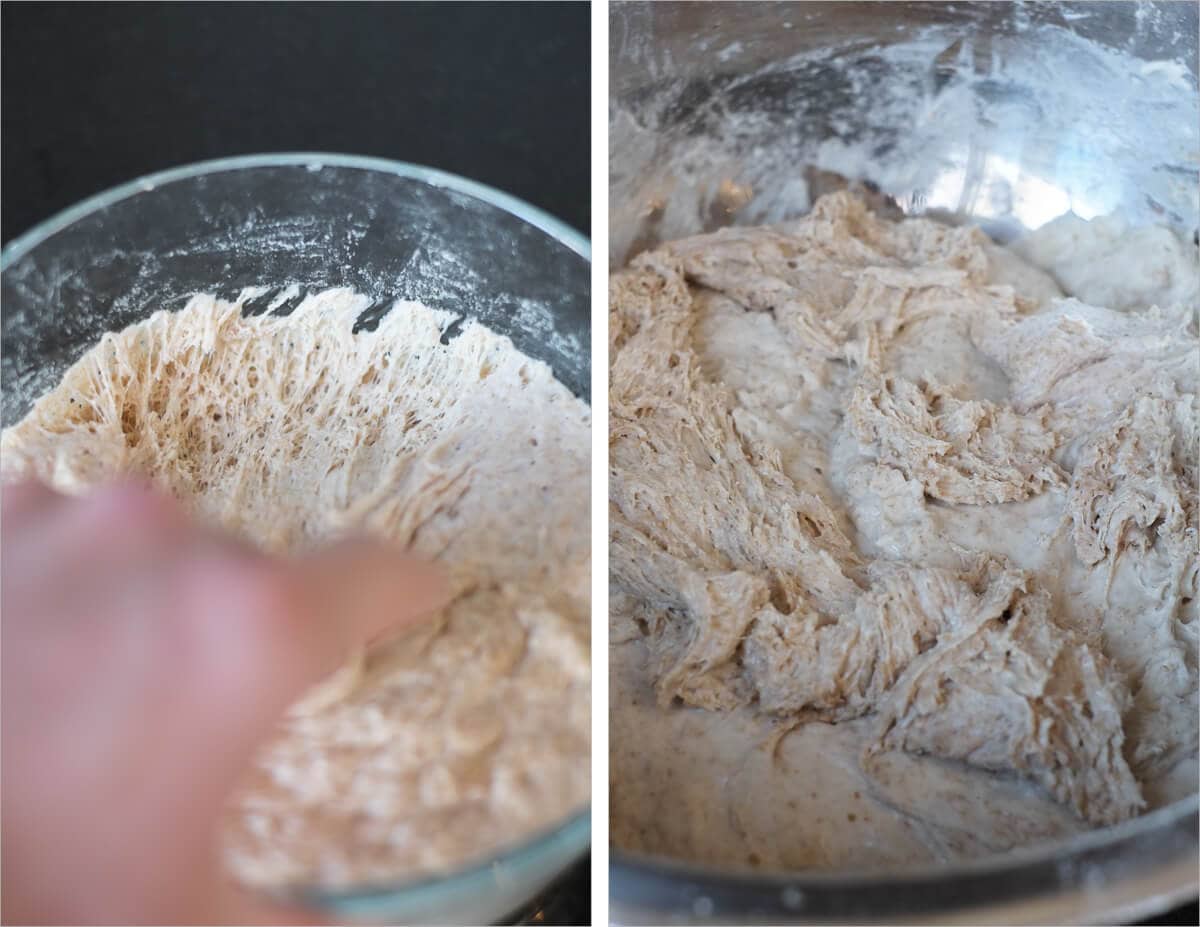
You can see above just how stiff my levain is — you tear it out of the bowl to lay on top in preparation for mixing. It makes for a bit more work when incorporating the levain, but it does help strengthen up the dough.
Autolyse & Mix – 1:40 p.m.
We will do a one hour autolyse with this dough.
Ingredients:
You will want to keep in mind with this recipe that spent grains will still have quite a bit of water contained within, unless whoever gave them to you dried them out. When I received my bags, the grains were still very wet, almost like a porridge. Adjust the hydration of your dough to suit: start with lower hydration, maybe around 700g, and increase in small increments. I ended up here at 800g total water, and I could have done with about 20g less in the end, but the crust & crumb didn’t suffer — I got lucky.
Gather the following:
| Weight | Ingredient | Baker’s Percentage |
|---|---|---|
| 100g | Giusto’s whole wheat flour | 10% |
| 50g | Bob’s Red Mill Dark Rye Flour (optional) | 5% |
| 850g | Central Milling Organic Artisan Bakers Craft (malted) | 85% |
| 800g | Water | 80% |
| 20g | Fine sea salt | 2% |
| 200g | Ripe, stiff levain (amount increased from last time due to cold weather) | 20% |
| 250g | Spent beer grains | 25% |
Perform the following for your autolyse:
- In a thick bowl add all the flour
- Add 750g of your water (the rest is reserved until later when we add in the levain & salt after the autolyse)
- Mix these ingredients by hand until all the dry bits are incorporated
- Cover with wrap and keep near your levain for 1 hour (in my case in the oven to keep warm)
Slap & Fold Mix after your autolyse – 2:40 p.m.
After our one hour autolyse has elapsed, and you’ve done all the research for your next bake, break up the stiff levain on top of the dough and pour on the 20g salt. Pour the remaining warm water on top to help dissolve things and to prepare for mixing.
Lately, I’ve eliminated the two,-step process of adding levain, mixing, adding salt, and mixing. Now, this doesn’t mean I only do one set of slap and folds, but I haven’t noticed any significant difference if mixing is done first without salt and then with salt. I could conjecture here, though, that adding salt might do some damage to the gluten network while strengthening after so many slap and folds, but I haven’t seen any proof of this.
Add the salt and levain at the same time and then proceed with mixing.
Slap and fold for about 5-8 minutes until the dough looks smooth and doesn’t stick to the counter. Return dough to the bowl and let rest for just a minute, then proceed to do another slap and fold session for about 5 minutes until the dough again looks smooth and has some strength to it.
We do an improved mix with this formula at the outset to build up strength in the dough before we add the spent grains (which will bring their own water to the dough).
| Final dough temperature: | 74°F (23°C) |
Bulk Fermentation – 3:00 p.m.
Transfer your dough to a clear container to be used during bulk fermentation and let rest for the first 30 minutes. After the first 30 minutes has transpired, perform your first set of stretch and folds.
- 4:30 p.m. – Turn Set 1
- 5:00 p.m. – Turn Set 2 – Gently fold in your spent grains after turn set 2
- 6:00 p.m. – Turn Set 3
After your second set of stretch and folds add in your spent grains until well incorporated. No need to brutally mix in the grains, pour them on top and fold them in gently. Subsequent folds will further incorporate the grains. You might need a small splash of water here to help the grains mix in thoroughly.
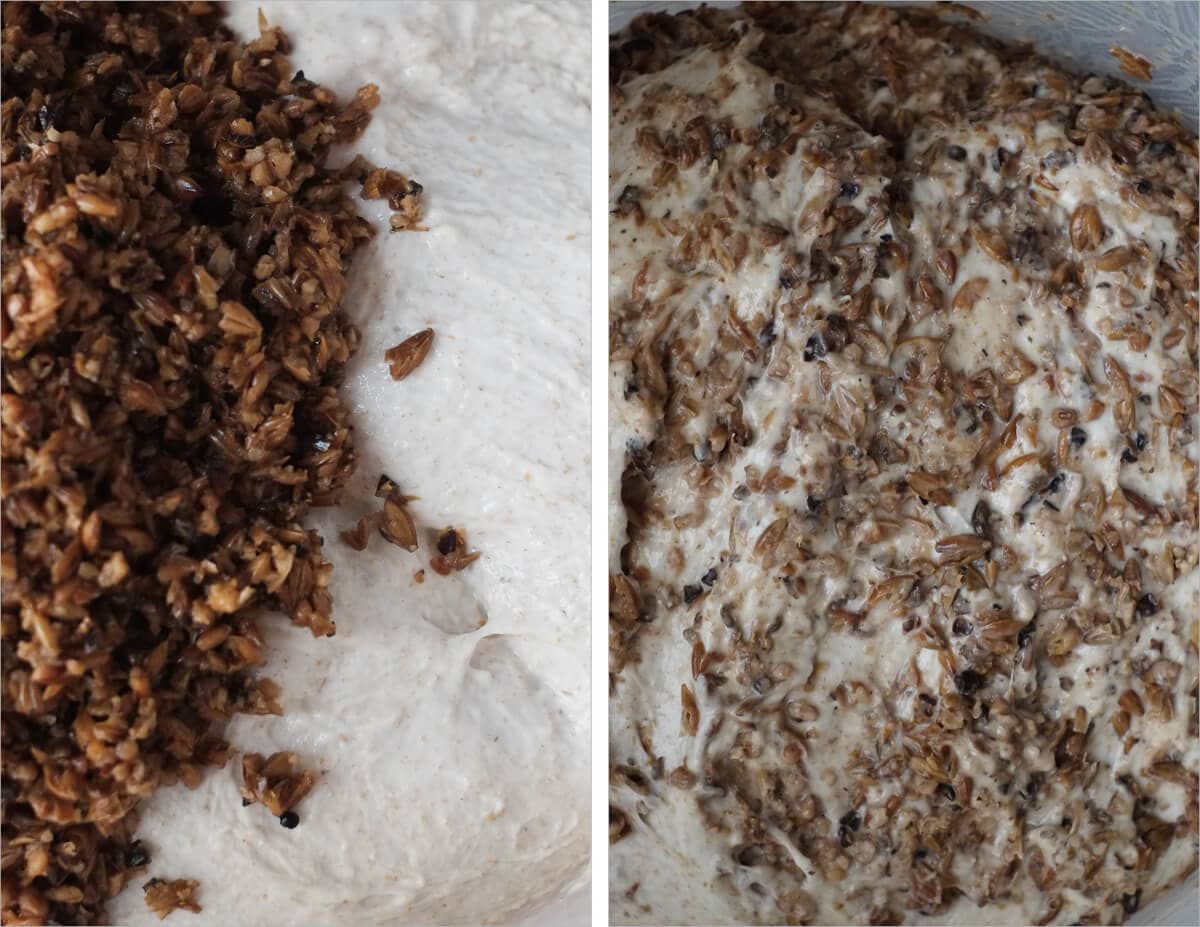
I found that my dough only needed three sets of stretch and folds thanks to my initial medium development achieved during the two slap and fold sessions. If you find your dough is super slack and not holding shape in your container, continue to do stretch and folds until it feels right to you. I know that’s a vague statement, but it’s hard to give any more description to this — deciding when to divide and shape your dough is one of the hardest things in baking.
Pre-shape – 7:45 p.m.
Gently pour out the dough from your bulk container and divide the dough roughly into two halves. I sometimes misjudge here and have one loaf larger than the other, but c’est la vie. If you’re more of a perfectionist, cut down the middle and lift one side onto your scale and compare it to the other half. Do it quick!
Using almost no flour, spin the dough around with your bench knife in one hand and floured second hand. You want a somewhat tight boule resting on the counter, but no need to over tighten here. We’ll let these two rounds rest for 20 minutes until they spread out a bit and relax, this way we can do our final shaping with much more pliable dough.
Shape + Proof – 8:05 p.m., Then in Fridge at 10:40 p.m.
It was starting to get into the darker parts of the night at this point for me, but it wasn’t quite time to rest — we’ve got the dough to shape. Shape each resting dough to your liking3 and place them into flour-dusted bannetons or kitchen bowls lined with a tea towel. Place these each into a plastic bag and let rest on the counter for 1 hour at room temperature (70°F/21°C). If it’s warm where you are, leave the dough out just for 30 minutes before placing it into the fridge. We want to get that final proof off to a good start before popping into the fridge as the typical home fridge runs somewhere around 38°F (3°C).
I always proof my dough in plastic bags in the fridge (or I proof them in my home-built dough retarder) to prevent a thick “skin” from forming on the outside, inhibiting optimal oven spring.
After this rest on the counter, you should have noticed your dough rise just a bit with some air bubbles on top and possibly at the sides. Place your bannetons with wrap into the fridge to proof overnight; we will bake these in the morning.
Score + Bake – around 8:30 a.m.
See my guide to baking in a Dutch oven or combo cooker for more information on the baking process below.
In the morning, preheat your oven with an empty Dutch oven inside to 450°F (232°C). When preheated, take one of your bannetons out of the fridge and cut a piece of parchment paper to place on top. Take your peel and then put it on top of those two and quickly invert it, so the dough is now resting on the parchment paper which is resting on the peel. If your dough has risen above your basket’s edge, don’t place the peel on top, smashing your dough. You want to be gentle here. You can quickly invert your basket with one hand on the basket and the other on the top of the dough to help it land softly on your parchment paper.
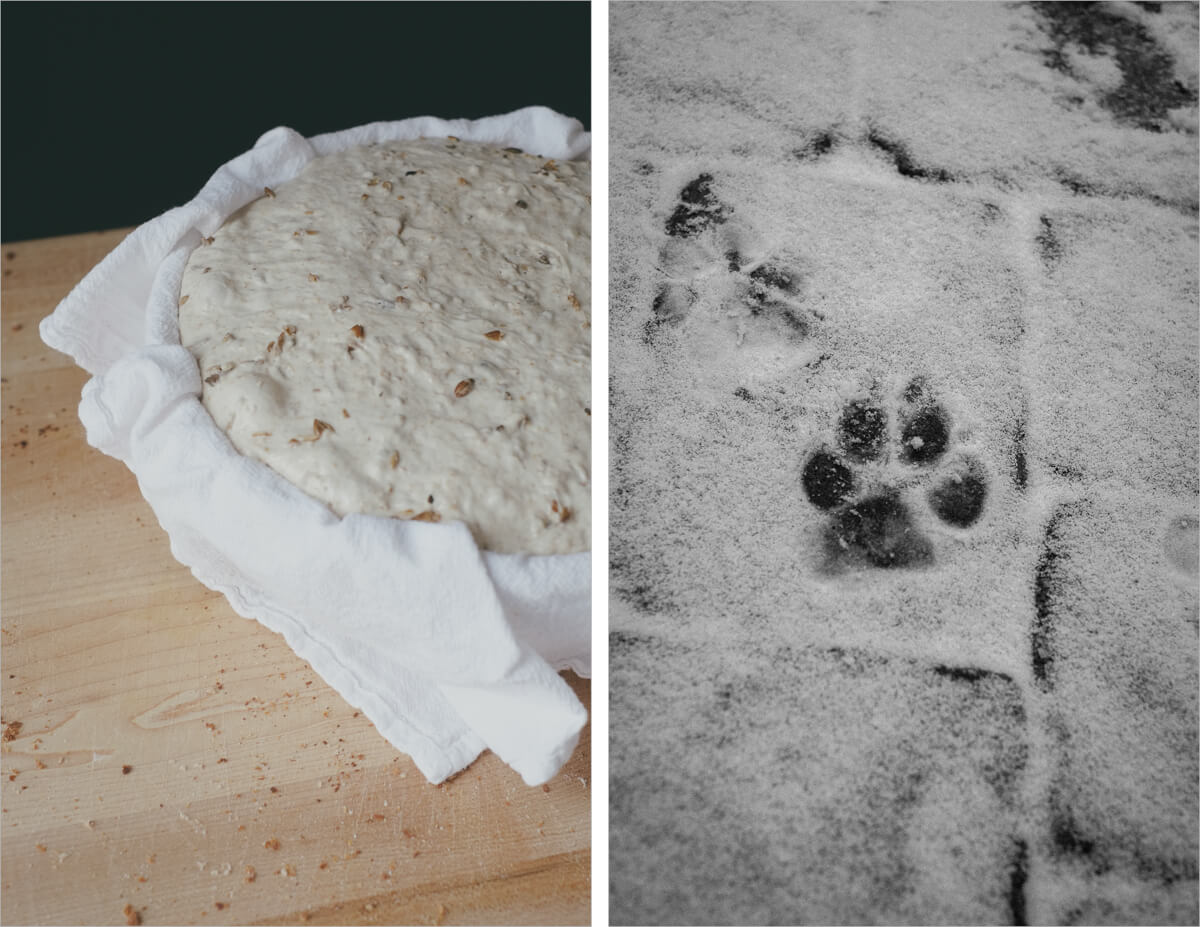
(Evidence of cold temps right above in that photo! My German Shepherd sure doesn’t mind, though)
Score the top of the dough quickly and assertively with whatever your imagination imparts in the morning. Here is where you might say my vision is lacking given I always do a crescent slash, well yeah maybe it is, but there is just something about the look of that adequately shaped batard with the ear reaching up to the sky — I can’t get past that.
Take out the shallow side of your Dutch oven and drag in your dough. Quickly place the pan back in the oven, cover with the deep side, and bake for 20 minutes. After 20 minutes, open the oven and take off the deep lid of the Dutch oven (set it next to the other half inside the oven), then cook for an additional 35 minutes or so, until the bread is to your desired doneness.
Conclusion
It’s a beautiful thing to be able to take what some consider excess and transform it into a delicious bread with a very nutritious slant. Since making this natural sourdough with spent beer grains, and sharing with my beer-making-friend, we’ve come to an understanding. A gentleman’s agreement whereby he provides me with his superb beer and spent grains, and I bake him bread with said grains in return. A win-win and perhaps, just perhaps, the beginnings of my sustainable baking business/co-op…
Crust
A dark and brooding crust. When you spot it you know you’re in for a substantial piece — it reminds me a bit of rye, if only by a hint. It was brittle no doubt about that, and crunchy in the mouth—fantastic. Because the grains held on to so much water, this bread stayed moist inside almost the entire week I was eating it.

Crumb
Tighter than my country bread, but understandably so given the addition of the sometimes sharp grain husks found within. To be forward, it is an excellent interior for this type of bread as it makes for the perfect vessel for that winter soup or stew. Heck, even a roast beef sandwich with heavy grain mustard, go all out with it.
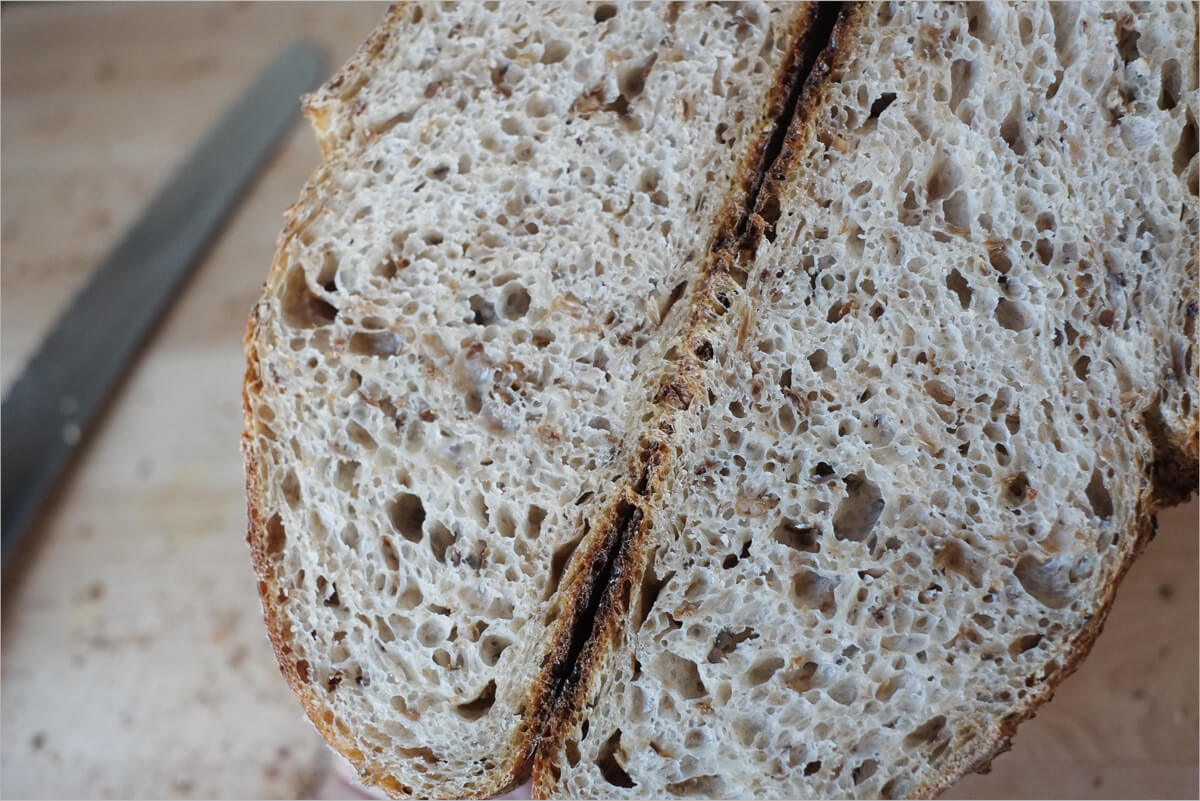
Taste
A very hearty bake. I mentioned this in the beginning, and I wanted to reiterate that here. Spent grains impart a strong nutty flavor to the bread — in a good way. After baking this, I would hesitate to go any higher on the percentage of grains mixed in as it might overpower the other wheat and slightly-sour flavors in the bread. It almost has a whole wheat flavor to it, even though this was predominantly white bread.
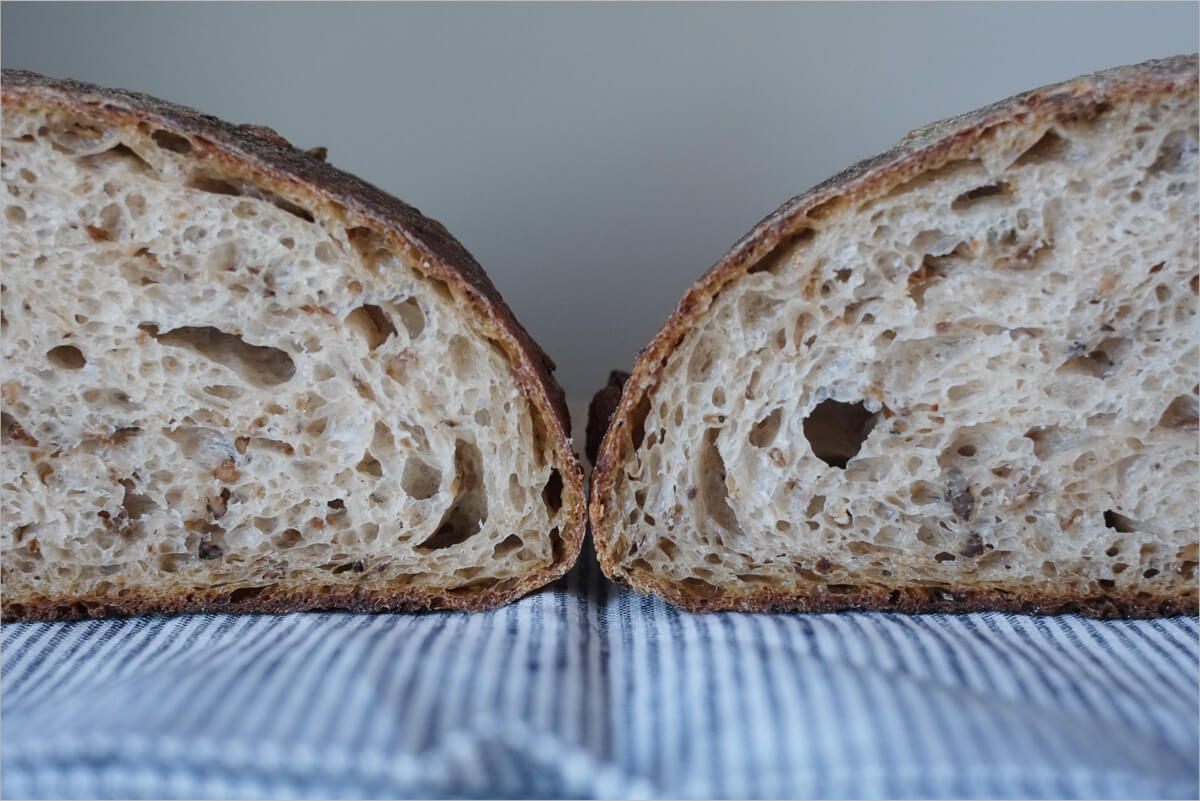
Hopefully, I find some of you out there making this same bread, and I’d love to hear your thoughts on your results. Just remember to keep the added grain percentage at, or below, what I’ve used here to start. Additionally, if your spent grain source dries out the grains you’ll have to adjust the hydration of your bread to suit, and conversely, if you obtain grains in a “porridge” like consistency like myself be ginger with your dough hydration to start.
I think this is going to be one of my staples for this year. Well, as long as my friend keeps brewing and providing me with his grains, and I think he will if I keep offering him some of the sourdough bread.
Buon appetito!
If you use this recipe, tag @maurizio on Instagram so I can take a look!
Marble is one of my favorite local microbreweries that has been in business here in Albuquerque for a long while now with a strong following.↩
Strict rules for some monks denote that they are not allowed to eat solid food during certain periods of the religious calendar, most notably Lent.↩
I seem to almost always default to shaping a batard, but sometimes a nice rustic boule is warranted.↩


